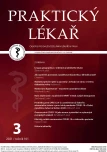Multidisciplinary care for patients with non-healing wound in the field of diabetic foot
Authors:
Adéla Holubová
Authors‘ workplace:
DiaPodi care, spol. s r. o. Soběslav, Vedoucí lékařka: MUDr. Lucie Chlupáčová
; Jihočeská univerzita v Českých Budějovicích, Zdravotně sociální fakulta, Děkanka: Mgr. Ivana Chloubová, Ph. D.
Published in:
Prakt. Lék. 2021; 101(3): 142-148
Category:
Of different specialties
Overview
In connection with the increasing incidence of diabetes mellitus, the incidence of patients with non-healing wounds in the field of diabetic foot syndrome is also increasing. Assessment of the overall condition of the patient, local assessment of the non-healing wound and surrounding tissues as well as assessment of deeper tissue structures serve as a basis for good wound management. Hygiene of the wound and its surroundings, debridement of wound bed, suitable limb relief, and patient education form an integral part of good wound management. The objective of the statement is not to provide a detailed description of a particular disease or present detailed case studies but show the process of selecting material for phase wound healing (individual products are given with their company names, with the addition of product categorization) and other procedures in the context of comprehensive/multidisciplinary care for patients with diabetic foot syndrome.
Keywords:
non-healing wound – diabetic foot syndrome – multidisciplinary care – phase wound healing
Sources
1. Dowsett C, Hallern B. The triangle of wound assessment: a holistic framework from wound assessment to management goals and treatments. Wounds Int J. 2017; 8(4): 34–39.
2. Jirkovská A, Bém R. Praktická podiatrie. Praha: Maxdorf 2011.
3. Jirkovská A. Syndrom diabetické nohy z pohledu internisty podiatra. Vnitř. Lék. 2016; 62(Suppl 4): 42–47.
4. Pokorná A. Úvod do wound managementu – příručka k hojení chronických ran pro studenty nelékařských studijních oborů. Brno: Masarykova univerzita 2012.
5. Pokorná A. Klinický algoritmus pro hodnocení nehojící se rány. Brno: Národní centrum ošetřovatelství a nelékařských zdravotních oborů 2013.
6. Pokorná A, Benešová K, Mužík J, et al. Data sources for monitorirng of non-healing wounds in a national heal information system-epidemiology of non-healing wounds analysis of the national register of hospitalized patients in 2007–2015. Cesk Slov Neurol N 2017; 80(Suppl. 1): 8–17.
7. Pokorná A., Mrázová A. Kompendium hojení ran pro sestry. Praha: Grada Publishing 2012.
8. Stryja J. Moderní postupy v léčbě nehojících se ran. Remedia 2010; 20(3): 180–184.
9. Stryja J. Debridement a jeho úloha v managementu rány. Praha: Geum 2015.
10. Woo K, Krasner D, Kennedy B, et al. Palliative wound care management strategies for palliative patients and their circles of care. Adv Skin
Labels
General practitioner for children and adolescents General practitioner for adultsArticle was published in
General Practitioner

2021 Issue 3
- Memantine Eases Daily Life for Patients and Caregivers
- Metamizole vs. Tramadol in Postoperative Analgesia
- Metamizole at a Glance and in Practice – Effective Non-Opioid Analgesic for All Ages
- Memantine in Dementia Therapy – Current Findings and Possible Future Applications
- What Effect Can Be Expected from Limosilactobacillus reuteri in Mucositis and Peri-Implantitis?
Most read in this issue
- How to (correctly) process and publish case report from clinical practice?
- Our experience with the use of NPWT methods and their availability
- Lingua geographica in the general practitioner’s surgery
- Clinical course of COVID-19 in a high-risk patient
